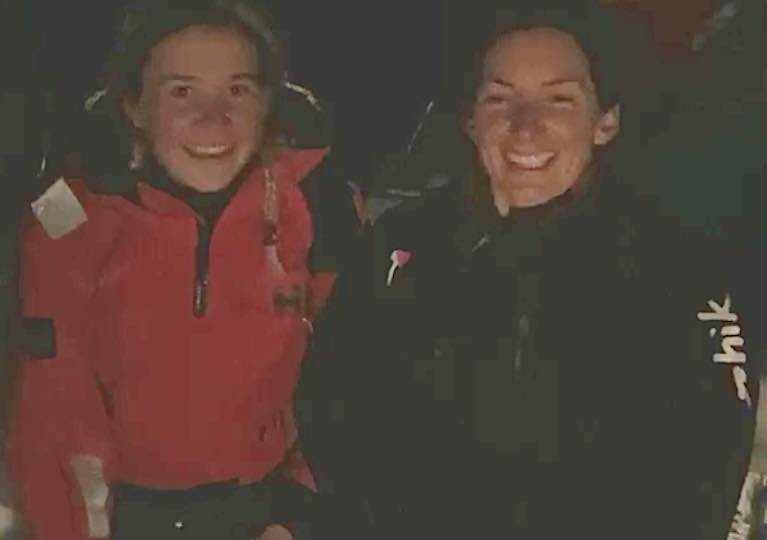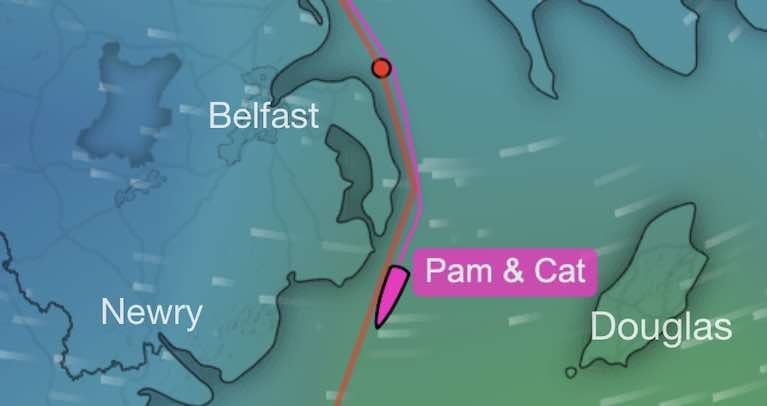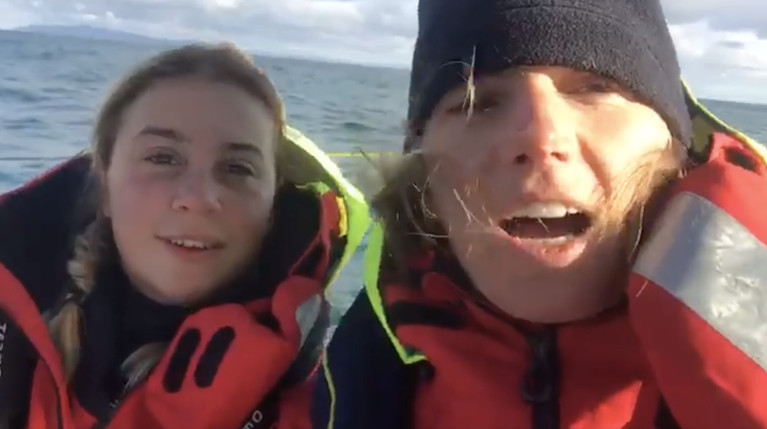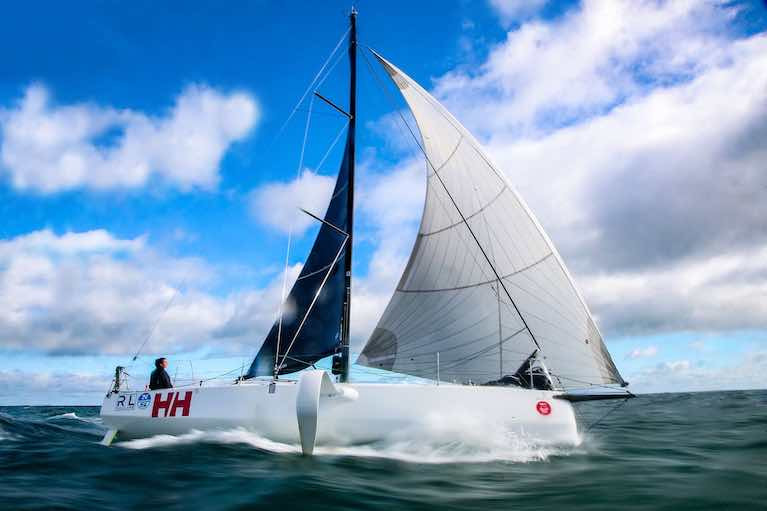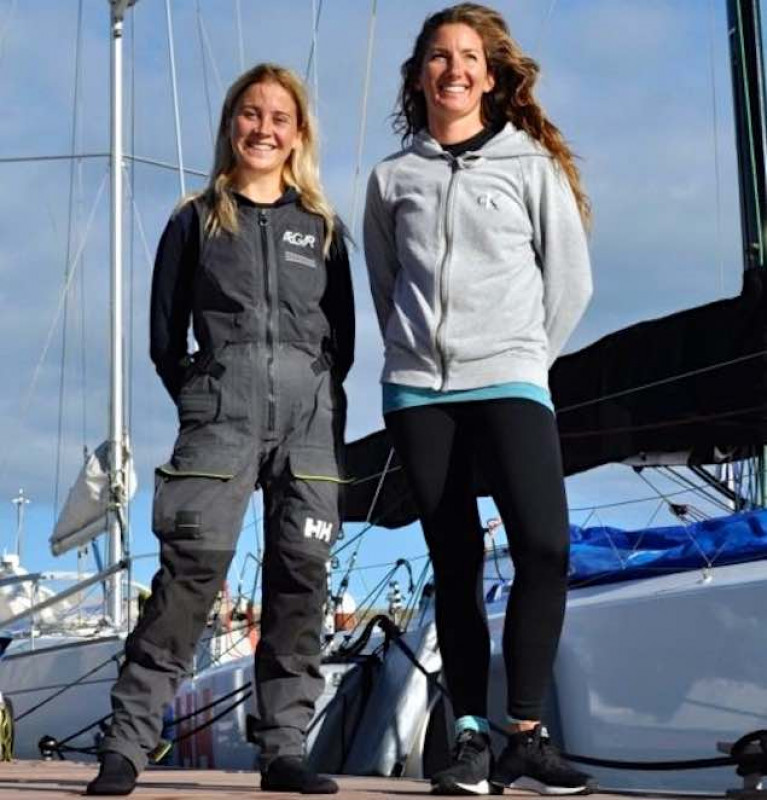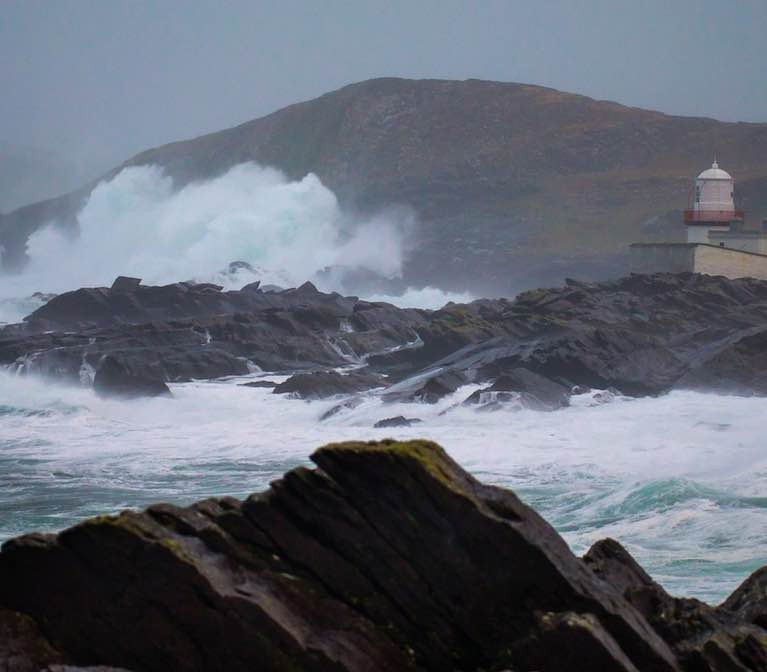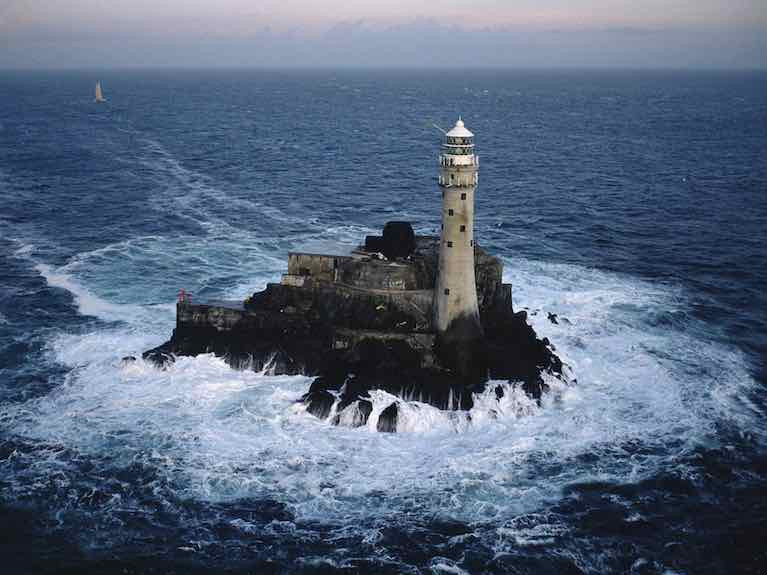Displaying items by tag: Cat Hunt
Pam Lee & Cat Hunt's Superb New Female Two-Handed Round Ireland Mono-hull Record Could Stand for Years
Female Two-handed Round Ireland Speed Record: The Iarracht Maigeanta Two-Handed Round Ireland Record Challenge by Pamela Lee and Cat Hunt of Greystones Harbour Sailing Club just got better and better through yesterday evening and last night as they swept – with impressively consistent speed - through the final hundred miles southward from the Antrim coast to a new record in Dublin Bay, riding on a potent combination of good sailing in a very workable mostly east to southeast breeze, and a fortuitously timed combination of favourable tides to finish at 0327 hrs this (Saturday) morning.
Yet at 1600hrs yesterday afternoon, as their Figaro 3 sat off the Antrim coast between Glenarm and Larne, virtually becalmed and locked in an adverse tide, few would have thought that such a magnificent performance could have been achieved following a frustating afternoon in which expected winds had failed to materialize.
But the transformation of their prospects was already complete by 1800 hrs yesterday evening. With the wind back again from the east and a strong new flood tide pushing them south along the Count Down coast with speeds soon getting into double figures, the possible time for their arrival at the World Sailing Speed Records Committee line in Dublin Bay from the Kish Lighthouse to Dun Laoghaire's East Pier in Dublin Bay just kept getting better and better.
Sailing Magenta Round Ireland Tracker
Yesterday afternoon, the hope of making it round within four days – that is, finishing before 0745 hrs on Saturday - was starting to look like a long shot. Yet by 2200 hrs last night, the continuing combination of favourable conditions was such that the four day circuit seemed well within sight and it was a question of by how much, with a finish time between 0400 and 0500 looking increasingly likely.
Well, they did even better than that again. In due course the very deliberative workings of the WSSRC will come up with their final figure. But according to the Yellowbrick Tracker loaned for the Iarracht Maigeanta/RL Sailing challenge by the Irish Sea Offshore Racing Association, Iarracht Maigeanta and her tired but very happy crew were home and dry around 0327 hrs.
For temporary convenience, let's conservatively call it 0330hrs. Thus Pam Lee and Cat Hunt have completed the circuit in 3 days 19 hours and 45 minutes. It's a fabulous performance, as the previous best two-hander by Aodhan Fitzgerald and Yannick Lemonnier in a Figaro 2 in the 2004 Round Ireland Race from Wicklow was 4 days and 6 hours, and that has long been thought an impressive figure.
We'll be doing a more detailed analysis of it all in the fullness of time. But just to give it further perspective and its proper historic position, the much-admired record established by Denis Doyle in the fully-crewed Frers 51 Moonduster in 1984 stood at 3 days 16 hours and 15 minutes. That a much smaller Figaro 3 sailed double-handed should get within three and a half hours of that monumental time is really very exceptional indeed, and the mood in Greystones, where Iarrache Maigeanta is now serenely home in her marina berth, is very rightly on a high as Pamela Lee and Cat Hunt take their well-earned chance to do a bit of serious sleeping for Ireland.
Read all of Afloat's coverage of this Round Ireland speed record in one handy link here
The Force is With Them Again – Female Crew in Maigeanta Iarracht May Make it Round Ireland Within Four Days
Female Two-handed Round Ireland Record Day Four 2100hrs: The situation became transformed. It was like the clicking of a switch. Or so it seemed to those on the edge of their seats ashore, as they watched on screen as the Figaro 3 Iarracht Maigenta struggled with little wind against the last of the ebb tide off the Antrim coast at Glenarm. First, there came the breath of a fresher breeze from between southeast and east to bring the boat to life. And then by 1800hrs, the new flood tide was surging them on their way, zapping two-handed crew Pam Lee and Cat Hunt south across Belfast Lough and past Mew Island in jig time, such that they were tearing along the County Down coast with their speed over the ground comfortably into the double digits.
Admittedly the pace slowed a little as they swept past the South Rock at 2000 hrs and began to get away from the most powerful stream of tide. But they'll still have something of it in their favour until St John's Point is abeam, provided the breeze keeps up.
Sailing Magenta Round Ireland Tracker
On the present rate of going, St John's will be there - though well to the west – around 2130, and this is where things start to get extra-interesting. If they can keep up their beam reaching speed around the 8 knots mark through the water, they can then make the classic hop of going from the last of the south-going flood as it peters out east of the entrance to Carlingford Lough, and make the leap across slack water for an hour or so until they then begin to feel the very first of the ebb in the new tidal system where the flood goes north, but the ebb is favourably going south.
It will be doing so with real determination as it accelerates south past Rockabill. As of 2100, Rockabill is still 48 miles away, while the finish line is 63 miles distant. You do the maths. If this good easterly breeze keeps up and they can be hovering between 7 and 8 knots through the water, the four day circuit is a distinct possibility, as to do it they've to be past the Kish by 0745 hrs tomorrow (Saturday) morning, and the current rate of progress allows them a bit of leeway on that.
But as we've seen, the winds today are in a capricious mood, even if a proper southeaster is in the offing. The tension in this project will be maintained right to the end.
More Uphill Work for Round Ireland's Pam Lee & Cat Hunt
Female Two-handed Round Ireland Record Day Four 1500hrs: The North Channel is one very unforgiving bit of water to go sailing on. It only gives you the gift of a fair tide for just long enough to begin to think that the dark cliffs of the inappropriately-named Fair Head and the gloom-inducing Mull of Kintyre aren't such oppressive bits of coastline after all as you buzz merrily along in the morning sunshine. And then the tide turns. The wind shuts down. And in near calm, you can appreciate only too well the sheer unfeasibly enormous vastness of this bulk of water moving in the wrong direction, struggling as you are to squeeze enough speed out of your boat simply to hold your own until the tide turns again. Meanwhile, the steep coastline becomes spookily claustrophobic.
We left round Ireland two-handed record challengers Pam Lee and Cat Hunt this morning as merry as grigs after they'd swept in past Rathlin with a grand fair flood tide at sometimes better than 12 knots over the ground. And we hoped that there was still enough life left in the flood to carry them well on their way towards the South Rock off the County Down coast, where tidal streams start to be less dominant.
But was not to be. At least they'd got a far as Glenarm, and south of the very worst of the foul tide. But the new ebb soon built up to strength, the wind – such as it was - drew more from the south and eased, and speeds of 2 knots or less over the ground became the order of the day.
Sailing Magenta Round Ireland Tracker
It will be 6 o'clock this evening before they have significant tide in their favour, but then it's good news, as every bit of southing they make taking them closer to the Irish Sea's relatively tide-free western sector. And it all brings them closer to the bit of more active weather that's distantly developing to the far southwest of Ireland, and should be preceded by a decent sou'easter which might even be the leading wind to bring them into Dublin Bay to complete the circuit within four days – deadline is 0745 tomorrow (Saturday).
But for now, they can have to live with seeing the Antrim coast in slow detail, and imagining life in Glenarm Castle up on the heights. It's the stronghold of the Mac Donnells, the Earls of Antrim, who were originally the Lords of the Isles in the Hebrides, but moved their HQ south when they found the real estate was of better quality in Ireland.
However, they never lost their love of the isles, so by tradition, each deceased member of the family is buried upright in the family graveyard on top of the hill so that he or she can look out over the coasts and islands and waterways that were their extensive domain.
But once upon a time, a notably unpopular member of the family died, and none of his relatives could be bothered to come home for the funeral. So the faithful retainers of the descendants of the Lords of the Isles struggled on their own up the hillside with the loathed one's very heavy coffin and buried him head down.
It's Pay-up Time for Iarracht Maigeanta in Tackling Headwinds & Strong Tides on Ireland's North Coast
Female Two-handed Round Ireland Record Day Three 2000hrs: When the going is good, the good get going - and they get going fast. This has been the mantra of Pam Lee and Cat Hunt, who brought their Beneteau Figaro 3 in past Tory Island and on to Ireland's North Coast at 1745 this evening (Thursday), just 34 hours after departing Dublin Bay with very focused use of favourable conditions in a clockwise circuit of Ireland, their mission being - as the Commissioner for Ireland for the World Sailing Speeds Record Committee has officially informed us today – the creation of "The Initial Women's Double-handed Around Ireland Record".
The semantics of it all can be resolved in the fullness of time. Right now, it's pay-up time. After hundreds of miles of favourable winds, they have the much more immediate problem of the southeasterly wind having a bit too much east in it, while lacking real oomph – the North Coast is proving to be hard work. Thus our hopes that they'd be just about able to lay Inishtrahull from Tory have been frustrated, as they're now hard on the wind and about 20 degrees below the required course. But at least the Figaro 3 is a performer, and at 1930hrs they were making 7.2 knots.
Regardless of its direction, so long as there's wind of some sort they can make progress, or can until they get into the seriously big tides east of Inishtrahull, and especially along and around Rathlin Island, which is not so much a tidal gate as more of a brutally uncompromising tidal drawbridge.
Sailing Magenta Round Ireland Tracker
East of Inishtrahull, it'll be a dead beat towards Rathlin, and as the tide will start running against them towards midnight, they may find it advantageous to tack inshore in slacker tides by Portrush, close past the spot where, in another life and about a million years ago, Shane Lowry was carving triumph for us all out of the Open Golf Championship.
Just as everyone was with Shane 15 months ago, so now the entire Irish sailing community is with the crew of Iarracht Maugeanta as the Date with Destiny at Rathlin draws nearer. Roughly speaking for the next two or three tides, the stream will be with them between 6 o'clock and 12 o'clock, so peak No-Go Time at Rathlin will be between one o'clock and 5 o'clock, regardless of day or night.
Admittedly the mighty tides at Rathlin are so weird that close in along the north cliffs, the stream is always running to the eastward. But to take advantage of that you have to be so close inshore that the cliffs play merry hell with the wind. One upon a time we were doing the Round Ireland Race in an ancient 83ft Maxi with a huge battered old mainsail which looked like it merited a tillage grant. With the ebb roaring outside, we were clawing along in daylight right inshore at Rathlin, and the cliff-nesting seabirds became so confused with this monster mainsail that some of them tried to alight on it. That's the kind of thing that happens racing past Rathlin - it's an otherworldly sort of place, not really part of Planet Earth at all.
The beating along the north coast by Iarracht Maigeanta was not unexpected, and with any luck when they finally get onto the northeast coast of Ireland, they may find themselves back on a beam reach and the knots buzzing merrily upwards. But for tonight, it's a case of known unknowns, and unknown unknowns. We wish them luck, and hope they close in on Rathlin through one of the favourable tidal windows.
Female Two-handed Round Ireland Record Day Three 0900hrs: At 0745 hours this morning, Pamela Lee and Catherine Hunt in the Beneteau Figaro 3 Iarracht Maigeanta had put County Mayo's northwest headlands of Eagle Island and Erris Head well astern, and were reaching across Donegal Bay towards their next major turning point of Tory Island off northwest Donegal in a moderate southeast breeze which provided reasonably smooth seas and steady progress.
Behind this deceptively humdrum progress report, there is a universe of achievement and competent campaigning. For 0745 hrs marked just two days into their circuit, which started from Dublin Bay on Tuesday morning. Yet by having the entire west coast of Connacht astern before those two days had elapsed, they were already well into the second half of their voyage.
Any boat sailing round Ireland from Dublin Bay in whatever direction reaches the halfway stage at Slyne Head off southwest Connemara, and in our signing-off report yesterday evening, we hoped they might be getting there near midnight. It was a qualified hope, as some forecasts were showing last night's cold calms over central Ireland spreading mistly over the Atlantic coast. But on the contrary, the coastal and offshore easterlies held up well, and while it was cold, progress was improving, and bang on time at midnight they were on the latitude of Slyne Head, though well at sea and sailing smoothly on course towards Achill at 8.8 knots.
Sailing Magenta Round Ireland Tracker
As they've reported to Shore Manager Kenneth Rumball, once they'd got north of the lumpier seas around the Blasket Islands yesterday, the steadier going enabled them to catch up on some sleep, but the uneven nature of the generally easterly wind's gradual progress of settling into being a steady breeze meant busy sail changes from time to time, yet they were still strengthening their mental and physical reserves for what looked like being a long cold night.
It was a cold night, but with the useful breeze on the beam and "the wind off the grass", the great headlands went past like clockwork, with Achill astern by 0330, and the dawn still barely hinting as Erris Head went by at 0615. Speeds were briefly reduced to 6.8 knots, but with the knots now up to 8.3 again as they make their way in a sou'easterly across towards Donegal at 0830 this morning, it's nicely on track.
Conditions are looking good for steady progress as far as Ireland's north point at Malin Head, as the course from Tory to the edge of the Malin and Inishtrahull outlying rocks is sufficiently north of east to continue to give them a leading wind. After Malin, it's a different sailing game entirely, as they're effectively into the beginnings of the North Channel's sailing problems of strong tides and frequent local wind variations all the way to the South Rock light off the County Down Coast.
It's always one of the trickiest stages. But as of now, with a real element of an easterly direction already being accommodated into their course to show they're homeward bound, the Pamela Hunt and Catherine Lee Two-Handed Round Ireland Challenge is going very well indeed.
Female Two-handed Round Ireland Record Day Two 0900hrs: The Magenta Round Ireland two-handed record challenge Record campaign from Dublin Bay by Pam Lee and Cat Hunt of RL Sailing and Greystones has logged an excellent start in its first 24 hours. They put the Fastnet Rock astern at 0400hrs this morning, and at 0745 hrs – just 24 hours after they started from the official records Kish Lighthouse-Dun Laoghaire Pier line in Dublin Bay – they were passing Dursey Head, the first headland of the majestic Kerry coast.
Having made many good miles in sometimes boisterous but always favourable northwest to northeast wind, they are now facing lighter conditions off the southwestern seaboard, something which had been predicted as the breeze veers until eventually, it's hoped, it will settle in more firmly as an easterly to give fair winds as far as distant northwest Mayo, when it's even possible another veering will provide a reach across to Tory Island.
 Pam Lee and Cat Hunt at 0945 this morning off the County Kerry coast. Scroll down for live tracker below
Pam Lee and Cat Hunt at 0945 this morning off the County Kerry coast. Scroll down for live tracker below
That's some time in the future. Meanwhile, the Magenta Shore Team, headed by Kenneth Rumball, are well pleased by the relatively steady progress past the often tricky stage from the Fastnet to Dursey. And while at Dursey Head itself there was a slight pause as speed fell back to 5.5 knots, they'd soon found the veering nor'easter had settled in with more vigour to give them better than 8 knots, and comfortably on track for the next course adjustment at Skellig Michael.
It's said that any single sailor, soldier or airman on active service needs about seven people providing background comprehensive support ashore, and while the Magenta Project direct shore management team doesn't quite reach the total of 14 this might suggest, nevertheless it's an impressive international array of talent. Headed by Kenneth Rumball of Irish National Sailing School, it includes communications co-ordination by Volvo Ocean Race media veteran Brian Carlin (originally of Kerry), while tactical and strategic advice is continuously available from ashore through Miles Seddon and Libby Greenhalgh, and additional support comes from Hannah Hunt (Cat's sister) and Abby Elher of the Agenta Project.
 Brian Carlin of Kerry headed the international press team on the 2017 Volvo Ocean Race and is much involved on the shore team with the Magenta Challenge
Brian Carlin of Kerry headed the international press team on the 2017 Volvo Ocean Race and is much involved on the shore team with the Magenta Challenge
Behind it all is the benevolent but very effective presence of Big Daddy. aka Marcus Hutchinson of Howth, Kinsale and Brittany, whose exceptional knowledge of campaigning a Figaro boat is rivalled only by his access to boat resources in areas like IMOCA 60s and the entire Figaro selection. It was Uncle Marcus who came up with the state-of-the-art Figaro 3 which had made this possible, and much helpful advice and encouragement with practical support has come from him with it.
There are many other less direct supporters in technical, equipment and sail services, while the stamp of officialdom is provided by Chris Moore of Dun Laoghaire, the former National YC Commodore who is currently in the onerous role of DBSC Honorary Secretary, yet somehow finds time to be Ireland's World Sailing Speed Records Commissioner too, and thus his presence on the start line yesterday morning in DBSC's Committee Boat Freebird made it all very official.
 Chris Moore of DBSC and the NYC is Ireland's World Sailing Records Commissioner
Chris Moore of DBSC and the NYC is Ireland's World Sailing Records Commissioner
Yet even with all the shoreside support and widespread goodwill, for much of the time, it comes down to two female sailors very much on their own out in the Atlantic in volatile weather. Although the next underlying problem may well eventually be a softness of wind strength as high pressure gradually comes to dominate the weather systems, yesterday evening there was plenty of wind about from the north as Magenta Project scooted along far at sea off the coast of East Cork, and at 1910hrs there was a sudden adjustment of course downwind and an easing of speed which caused concern for those ashore about sail or rigging damage.
But instead, it was a prudent easing of the pressure in order to change as safely as possible from the A5 spinnaker - which had carried them so well and so quickly from Dublin Bay - to the now more useful Code Zero, and in the relatively conservative approach which had underlined the first day of the challenge, this was very much the right way to do it, and soon they were back to 12.5 knots, and blasting west into the night, on towards the Fastnet.
Sailing Magenta Round Ireland Record Tracker
Round Ireland Two-Handed Challenge Speeds West into the Night Towards the Fastnet Rock
Female Two-handed Round Ireland Record Day One 2000 hrs: The Round Ireland two-handed record challenge by Pamela Lee and Catherine Hunt, which started from the Kish in Dublin Bay at 0745 this morning, had been accelerating westward well out to sea off the East Cork coast, putting them due south of Capel Island at 1930hrs and making 12.5 knots. Their Beneteau Figaro 3 was beginning to feel the effects as the strong north to northeast winds - 25 knots and more in the Irish Sea and St George's Channel all afternoon - start spreading vigorously into the Atlantic.
Not that the Magenta team need more pressure power, as they've had a very handy favourable breeze all day. But through the early part of the night they've been having to handle this extra challenge of keeping up speed without sustaining any damage before the blast of extra wind has gone through, and at 1910hrs a problem arose and they peeled off for twenty minutes on a downwind course, but still sailing at 8.3 knots. Yet now (1940 hours) they're back up to 12.4 knots and it seems to be all systems go again.
Ironically, although they're on a record-establishing mission, they don't want to arrive down at the Fastnet Rock too early, as on the current setup, it gets very bumpy thereafter. From The Rock northwestwards, the wind has been more then fresh from the north along the Kerry and West Cork coasts through today, and as any Round Ireland and indeed Dun Laoghaire-Dingle Race veteran can affirm, slugging into a strong northerly off Kerry is no cakewalk.
But fortunately for the two co-skippers, the wind is expected to veer markedly and ease as it draws from the east, helping them round the corner and past Ireland's most westerly point, the unmarked Great Foze Rock west of the Blaskets, a lonely and mysterious place which is best avoided by night or day.
For now, however, that's in the future as supporters ashore wait to hear what caused the sudden alteration of course at 1910hrs, hoping that it was only a blip rather than the loss of an important sail or some rigging damage.



























